|
 |
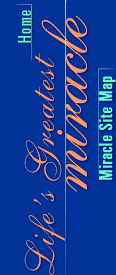 |
|
| 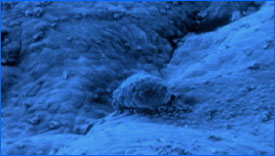 So humble an entity, so hot a
potato: a blastocyst-stage human embryo, from which specialists glean embryonic
stem cells.
So humble an entity, so hot a
potato: a blastocyst-stage human embryo, from which specialists glean embryonic
stem cells.
|
The Stem-Cell Debate
by Ronald M. Green
Editor's note: The author was a member of the National Institutes of
Health's Human Embryo Research Panel in the mid-1990s. The panel recommended
ethical guidelines for all future federally funded research on human embryos.
These guidelines helped influence President George W. Bush's decision in August
2001 to permit federal financing for research on human embryonic stem (ES)
cells using established ES cell lines.
Stem-cell research has enormous potential value in both medical and commercial
terms. Stem cells are the progenitors of all specialized cells in the body.
Blood stem cells (hematopoietic cells) reside in bone marrow and continuously
produce a variety of blood and immune system cells. Mesenchymal stem cells are
the source of new bone, cartilage, and connective tissue cells. Neuronal stem
cells produce a variety of nervous system tissue, mostly during early embryonic
development but, as we are beginning to learn, later in life as well. During
early development the precursors to all these more specialized stem cells,
sometimes called "pluripotential stem cells" (PSCs), are found in the inner
cell mass of the preimplantation embryo and in certain cell populations of the
early fetus.
Stem-cell research took a great leap forward in 1998, when two independent
research groups, led by Dr. James Thomson of the University of Wisconsin,
Madison, and Dr. John Gearhart of Johns Hopkins University, reported success in
growing human stem cells in culture. Thomson and Gearhart, using
different approaches, had isolated these very early precursor cells and spread
them out on a feeder layer of mouse cells to produce an immortalized
pluripotent human stem cell culture. Research showed that the resulting cell
lines produce the enzyme telomerase, which resets the cells' chromosomal clocks
and prevents the timed death suffered by most differentiated cells. This
resetting allows the cells to be cultured indefinitely during repeated cell
divisions (or passages).
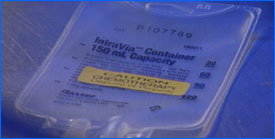 One day, doctors treating
a cancer patient with chemotherapy may be able to replace his or her damaged
blood or marrow cells with new ones grown from ES cells.
One day, doctors treating
a cancer patient with chemotherapy may be able to replace his or her damaged
blood or marrow cells with new ones grown from ES cells.
|
|
In the future, when better understanding has been gained of the growth factors
that induce specific forms of cell differentiation, immortalized PSC lines like
these may be induced to produce specific tissue types. It would then be
possible to generate in the laboratory insulin-producing islet cells to cure
diabetes or dopamine-producing cells, the absence of which causes Parkinson's
disease. Also on the distant horizon lies the possibility of new cardiac tissue
for heart attack victims, replacement blood and marrow cells for those who have
undergone chemotherapy or radiation therapy for cancer, new skin tissue for
burn victims, bone for those suffering from severe fractures or osteoporosis,
and so on. Closely studied, stem cell lines might give scientists new clues
about the growth factors that drive tissue differentiation from the earliest
embryonic stage forward. This would permit new understanding of cellular
abnormalities, including cancer, and new ways of steering cell differentiation
in desired paths.
Thomas Okarma, president of the Menlo Park, California-based Geron
Corporation, which funded Thomson's and Gearhart's work in return for exclusive
licensing of the technologies the two teams developed, articulated Geron's
corporate hope and a likely reality when he predicted that in the
21st century, cell-replacement therapies based on pluripotent stem
cell lines will render obsolete many current drug and medical interventions. At
the end of 1999, the journal Science, in a special cover article and
editorial, declared pluripotent stem cell research to be the scientific
"breakthrough" of the year.
|
In 1999, the journal Science
declared pluripotent stem cell research the scientific "breakthrough" of the
year.
|
A funding issue
Major legal, ethical, and political hurdles stand in the way of these advances. In
large part, these obstacles result from the fact that, of the three sources of
stem cells, human embryos are the most promising. One source is the "adult," or
mature, stem cells that reside in the body from infancy onward. These cells are
"multipotent," meaning they are able to produce a range of related tissues,
such as the differing types of blood system cells. A second source is embryonic
germ cells that are derived from the primordial reproductive tissues of aborted
early fetuses. These are the cells that John Gearhart used in his research.
They are pluripotent, able to give rise to all tissue types, although recent
research suggests that their usefulness in cell-replacement therapies might be
limited because they have already begun to take on some specific
characteristics of their reproductive function.
Finally, there are ES cells, derived from the inner cell mass of
blastocyst-stage embryos. These pluripotent cells are the most ubiquitous of
all. Once removed from the blastocyst they lack the outer trophoblast
structures for continued embryonic development, but they can theoretically be
"nudged" into becoming any cell type found in the human body. These are the
cells that Thomson used in his research.
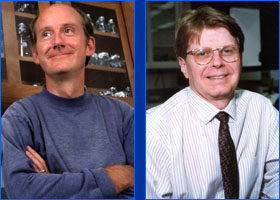 In a trice, the groundbreaking work of James Thomson (left) and John Gearhart
brought the issue of government funding of stem-cell research to the
fore.
In a trice, the groundbreaking work of James Thomson (left) and John Gearhart
brought the issue of government funding of stem-cell research to the
fore.
|
|
Publication of Thomson's and Gearhart's studies made the issue of federal
support for human embryo research unavoidable. Gearhart's use of tissue from
aborted fetuses could be federally funded because research using cadaveric
fetal tissue is currently not prohibited by federal law. However, Thomson's use
of spare human embryos provided by the University of Wisconsin's infertility
clinic would be a direct violation of the existing ban on federally funded
human embryo research. In order not to imperil the university's massive budget
of government-supported research, Thomson set up a separate lab in a building
across campus from where he did his NIH-funded research.
Three issues spurred the debate over whether or not the government should fund
stem-cell research. One concerned the moral status of PSCs themselves. Are they
morally protectable entities, or are they more like other disposable tissues
gleaned from the human body? A second issue concerned the derivation of PSCs.
Assuming that at least during the earliest phases of research, human embryos
produced via in vitro fertilization (IVF) would be the best source for
producing immortalized stem cell lines, could research go forward that depended
on the dissection of living human embryos?
| 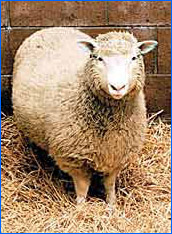 Someday
researchers may create new ES cells lines using a technique similar to that
brought to bear in the birth of Dolly, the famous cloned sheep.
Someday
researchers may create new ES cells lines using a technique similar to that
brought to bear in the birth of Dolly, the famous cloned sheep.
|
Finally, there was the question, still somewhat remote but now looming: whether
to permit the creation of research embryos. For cell-replacement therapies to
fulfill their promise, cell lines must be produced that can overcome rejection
by the recipient's immune system. The hope is that we will develop enough
knowledge to do this by manipulating the immune system factors of standardized
pluripotent stem cell lines. If this is not possible, each therapeutic
intervention will require the preparation of tissues that are immunologically
suitable (histocompatible) for the patient.
One way to do this might be to combine Thomson's stem cell work with the
cloning technology developed by Ian Wilmut and his colleagues at the Roslin
Institute. (In 1997, Wilmut and his team announced the birth of the cloned
sheep Dolly, the first mammal cloned from the cell of an adult animal.)
A somatic cell could be taken from the recipient individual, its nucleus
inserted into an enucleated egg cell that is stimulated to begin dividing, and
the resulting blastocyst-stage embryo then disaggregated to produce a
histocompatible pluripotent stem cell line.
Continue: Moral Seasoning
Watch the Program |
The Stem-Cell Debate |
Windows on the Womb
Great Expectations |
How Cells Divide |
How is Sex Determined?
Resources |
Teacher's Guide |
Transcript |
Site Map |
Life's Greatest Miracle Home
Search |
Site Map |
Previously Featured |
Schedule |
Feedback |
Teachers |
Shop
Join Us/E-Mail |
About NOVA |
Editor's Picks |
Watch NOVAs online |
To print
PBS Online |
NOVA Online |
WGBH
© | Updated November 2001
|
|
|
|